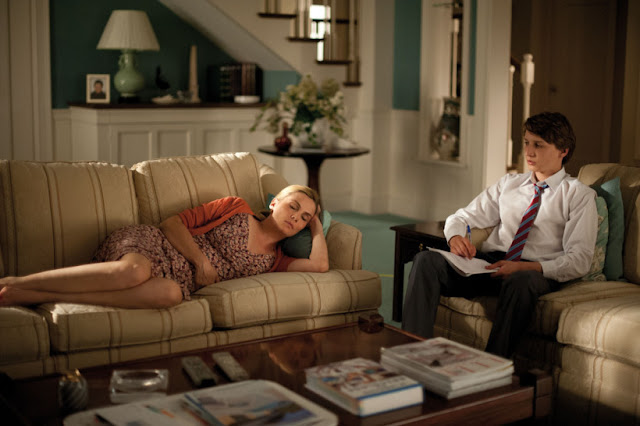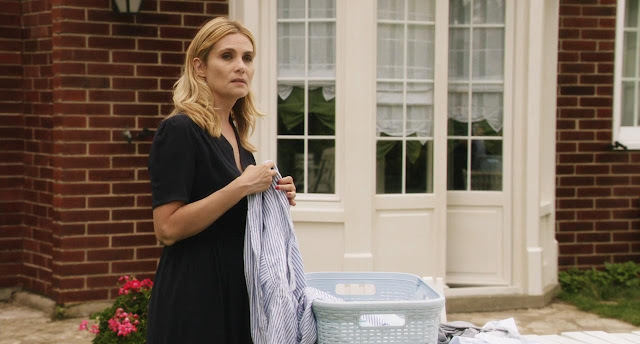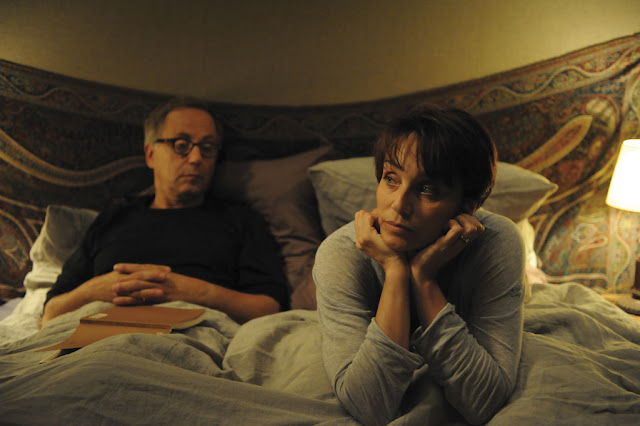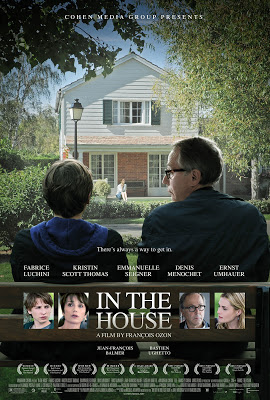 |
| In the House movie poster |
|
Spoiler Alert
Francois Ozon’s
In the House (or
Dans la Maison) is actually quite good. It’s an intelligent film with brilliantly portrayed, complex, interesting characters along with pathos and moments of poignant humor. The film is very aware of social class dynamics, showing the interplay of working class, middle class, and the intelligentsia. Germain is a jaded teacher who sees the writing talent in his student Claude, a smart, working class kid with a sadistic streak. As Germain nurtures Claude’s “gift,” both their lives spiral out of control. Using an engaging meta-narrative to show the story-within-the-story through its chapters and revisions as Claude integrates Germain’s instruction, Germain becomes obsessed with his student and the story he writes. We begin to wonder about the potential maliciousness of Claude’s manipulations, not only of the family “in the house,” but of Germain himself. Who is really the teacher and who is the pupil? Where is the line between fantasy and reality?
Though I enjoyed the smart plot and fine performances, I found myself on the fence about the female characterizations. First, there’s Esther (played by Emmanuelle Seigner), the matriarch of the Artole family.
 |
| Esther sleeps while Claude voyeuristically writes about her feet. Women, he finds, are easier to admire when they’re asleep and can’t challenge him or make him feel inadequate. |
Claude is sexually attracted to her, longs for her as a replacement for the mother who left him, and resents and envies her for her class status. Claude mocks her as stupid, painting her in his narrative as coarse and frivolous. Germain isn’t too concerned with the lack of sophistication Claude’s writing exhibits as it turns Esther into little more than an object of desire (albeit the desire itself is rendered as complex and multifaceted). Germain, instead, insists that the key to the story is the fleshing out of the young Rapha character.
Claude derides and inwardly sneers at Esther for her obsession with the house. She constantly flits through home magazines and goes on about the drapes and building a veranda. Esther’s identity is reduced to the house. Claude never really sees or appreciates her loneliness and the deep, abiding unhappiness in the objective correlative of the house.
 |
| Esther folding laundry, noticing Claude staring at her from a park bench. |
Claude never realizes that the house is every bit as much a symbol for him as it is for her, though the permutation is different for each of them. For Claude, the house is an escape into another, better life with inhabitants who he’s free to toy with and manipulate to manifest his own desires. For Esther, it is a prison and a life preserver that she continues to beautify in the hopes that she won’t have to keep staring at the bars. Not only that, but Claude never recognizes that Esther is the keeper of this house that he desires so much; she is the one who lovingly cares for its physicality while internally sacrificing much to keep its inhabitants happy and together (even, in the end, giving up the house itself so that her husband can follow his dreams).
Then we have Jeanne (played by Kristin Scott Thomas), Gillam’s intelligent, insightful wife who operates an art gallery.
 |
| Jeanne sits in bed contemplating the tale Claude weaves as well as the nature of the weaver himself. |
Germain shares young Claude’s chapters with Jeanne, and while Germain becomes engrossed in the boy’s story and writing talent, Jeanne constantly reminds us to think of the troubled boy crafting the tale. Jeanne also observes the way this obsession is affecting Germain, the only one outside the story enough to keep bringing reality back into play. She cites Germain’s loss of sexual appetite, postulating that he may be attracted to his student; Germain’s prioritizing Claude’s writing over the desperate situation at her art gallery where her job is in jeopardy; and Germain’s losing his moral compass as he helps Claude and Rapha cheat in order to keep Claude within the house and writing. She is the one who breaks the fourth wall by inviting the Artole’s to an art opening at her gallery.
 |
| Germain is horrified that Jeanne has invited the Artoles, as he’d prefer to imagine them as fictitious. |
To Claude, Germain mocks the art Jeanne curates as pretentious. Germain is threatened by her intelligence and effortless insight into the human psyche as proven by her astute grasp of Claude and the characters he portrays. Claude ends up weaving Jeanne into his narrative, ending their encounter with sex, a scene that is dubious in its veracity. This non-consensual representation is a violation of her personhood. Her agency disappears with her as we never find out what becomes of her after Germain murderously chokes her after reading Claude’s rendering of his meeting with Jeanne. Germain’s vicious attack is borderline absurdist in its ferocity, and I was left wondering if the scene was intended to be humorous … I assure you, it was not. Germain’s assault seems more about the loss of another
thing that belonged to him (his wife is to his job is to his reputation) due to Claude’s story as well as his own obsession.
Not only does Germain become completely unsympathetic to me in that moment, but the female characters are revealed to be little more than narrative devices. The ending of In the House makes it clear that the film was always and only about the relationship between Germain and Claude. As the two sit together on a bench bereft of everything but each other’s company and their stories, it becomes clear that the narrative was always about the power play between instructor and pupil. Other people were merely obstacles that stood between them to be maneuvered like chess pieces until these two men were on equal footing, a sort of stalemate with only the kings left standing on the board.
At first, I hoped the film was calling attention to the way that both Germain and Claude don’t really see the women in their lives, don’t allow them to be full human beings, but upon further analysis, it becomes apparent that the film itself only uses the female characters as convenient props to help elucidate the male narrative replete with its masculine struggles.















